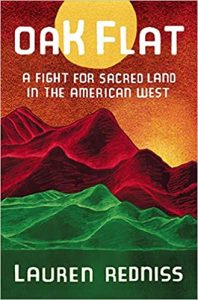
Oak Flat: A Fight for Sacred Land in the American West
By Lauren Redniss
Reviewed by Kate Jackson
This is a stunning visual nonfiction book written by an award-winning author with the eye of an artist and the voice of a journalist. From the opening pages with their vivid illustrations interspersed with text to the final black pages with white print, the reader is introduced to a clash of cultural values of immediate relevance.
Oak Flat is part of the Tonto National Forest, about 65 miles east of Phoenix, Arizona. It is a popular hiking, birding, and camping area 15 miles from the San Carlos Apache Indian Reservation and near the town of Superior. The land also sits above a large copper deposit worth billions of dollars and coveted by Resolution Mining Company, LLC. Apaches consider Oak Flat to be sacred ground where they gather medicinal plants and acorns and continue to pray and perform ceremonies passed down by generations. The proposed mine would eventually create a large crater to replace the land and make the site unrecognizable. Residents of the town see jobs and increased economic activity from the mining operation.
The book provides rich visual representations of Oak Flat while weaving a narrative based on interviews with members of an Apache family, the Nosies, and descendants of early settlers of Superior, the Gorhams. Wendsler Nosie served on the San Carlos Tribal Council and was tribal chairman before forming the Apache Stronghold, an alliance of Apaches and others determined to stop the copper mine. The Sunrise dance which reenacts the Apaches creation myth at Oak Flat, is seen through the eyes of his granddaughter, Naelyn Pike. The Gorhams represent the perspective of workers in the mines and community members who have experienced the boom and bust of previous mining operations.
The fate of Oak Flat has not been resolved as the Forest Service recently rescinded the environmental impact assessment necessary for the mining project to proceed. Pressures for increased copper production will continue to mount as the movement towards “clean” energy solutions to reduce carbon emissions are advanced. Large amounts of copper are necessary for solar panels, wind turbines, electric vehicles, and battery storage. Where do sacred spaces fit into the equation of costs and benefits?
The Writer’s Workshop Book Review regularly publishes reviews of fictional and nonfiction narratives from traditional publishing houses. If you would like to write a review or have your own book reviewed, please let me know.
 The Writer's Workshop
The Writer's Workshop 











